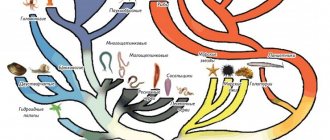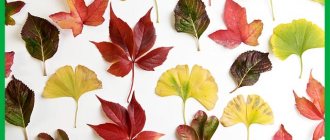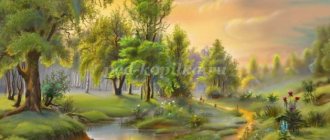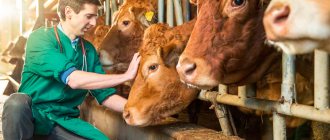MAGAZINE Preschooler.RF
Murtazina Rezeda Vagizovna Teacher IKK MDOU Kindergarten No. 143 combined type “Rainbow”, KazanProgram content: Learn to identify the distinctive features of wild animals, write descriptive stories about animals, and correctly express your thoughts. Improve the ability to form nouns with a diminutive suffix. Activate and expand your vocabulary on the topic “wild animals”. To consolidate children's knowledge about wild animals (appearance, housing, food). Develop visual perception, speech hearing, memory, attention. Develop the ability to listen to the answers of comrades and respect for animals. Preliminary work: Reading stories about animals, solving riddles, looking at illustrations.
Demonstration material: Illustrations depicting wild animals, Object pictures, Envelope with a letter, Squirrel toy.
1. Organizational moment. Guys, I’ll tell you a riddle now. When you guess it, you will find out who will come to your class. Who leaps through the fir trees deftly and climbs the oak trees? Who hides nuts in a hollow? Drying mushrooms for the winter? That's right, it's a squirrel. And here she is. What's that in her hand? Some kind of letter. (the teacher reads it)
Come urgently, Help urgently. The wizard scared us. He put a spell on us all. We have forgotten who we are. What should we drink and what should we eat? Help me out, help me. And urgently reconcile us. (forest inhabitants) 2. Conversation. Guys, tell me, who are these forest inhabitants? Name it. (children list animals) What are the names of the animals that live in the forest? (wild, forest) Why? (they get their own food, build homes, take care of the cubs) What happened to the forest dwellers? Can we help them? Then we’ll say the magic words to find ourselves in the forest. 1,2,3,4,5 – we go into the forest to save animals (music plays, children approach the trees). Here we are in the forest. 3. Did. a game. Guess by the description. Guys, look. There are a lot of trees in the forest, but no animals are visible at all. What are these white cards that lie under the trees? To find out, you need to listen carefully to what the squirrel has to say. As soon as you guess who it is, the card can be turned over. -angry, hungry, gray (wolf) -small, long-eared, gray or white (hare) -red-haired, dexterous, cunning, fluffy (fox) -big, clumsy, club-footed (bear) -small, prickly, gray (hedgehog) ( As they are named, object pictures open and animals appear) Here, squirrel, the children named the forest animals. And now we will sit down on the forest stumps and name the baby animals. 4. Finger gymnastics. This is a little hare, This is a little squirrel, This is a little fox, This is a wolf cub, And this is a brown, shaggy, funny bear cub in a hurry, hobbling sleepily. Which of the forest animals did we not name? (hedgehog) 5. Poem “Everyone has their own home” Squirrel, and Adilya wants to tell you a poem. A fox in a deep forest has a hole - a safe home. Under the bushes a prickly hedgehog rakes leaves into a heap. The clubfoot sleeps in the den until spring, and he sucks his paw. Everyone has their own home. Everyone is warm and comfortable in it. 6.Did. game "Who Lives Where?" The squirrel wants to know, do you know where wild animals live and what their homes are called? Children's answers. The fox lives in a hole, the bear sleeps in a den, the wolf lives in a den. Does the hare have a home? (no, he’s hiding in the bushes) Do you know where I live? - asks the squirrel. In the hollow. Everyone has dwellings, which are called differently. So we reminded them. 7.Did. game “Who Loves What” Guys, in the squirrel’s letter it was written that the animals forgot what they should eat and what they should drink. Let's help them. You know what wild animals eat. On the board are subject pictures (raspberries, honey, pine cones, mushrooms, apple, cabbage, carrots, nuts, grass, mouse, hare). Children choose a picture. Tell me who likes to eat this. The hare loves carrots and cabbage. Squirrel – nuts, mushrooms. The hedgehog loves mushrooms and apples. Bear – honey, berries. The wolf catches mice. The fox hunts for mice, hares, and chickens. And now we will show how animals move. Fizkul On a hot day, the animals walked along a forest path to a watering hole. A hedgehog was sneaking behind its mother fox. A little hedgehog was rolling after its mother hedgehog. A bear cub followed the mother bear. The baby squirrels jumped after the mother squirrel. Behind the mother hare there are slanting hares. The she-wolf led the wolf cubs behind her. All mothers and children want to get drunk. 8. Did. Game “Finish the Sentence” The squirrel makes a request to you. She has the beginning of a sentence; she needs to finish the sentence by saying the word that has the opposite meaning. The hare is white in winter, and in summer... The hare has a short tail, and the ears... The hedgehog is small, and the bear... The squirrel is gray in winter, and in the summer... The squirrel has a long tail, but the hare... The squirrel lives in a hollow, and the fox in a hole... The fox is cunning, and the hare... The hare is fluffy, and the hedgehog... Well done, guys, you helped the squirrel and completed the task. 9. Did the game “Fourth is odd” The evil wizard mixed up all the animals. Help me find out who is the odd one out here. -fox, bear, hare, woodpecker -wolf, hedgehog, horse, fox -hare, elephant, bear, squirrel -hedgehog, she-bear, little hare, little fox -chicken, squirrel, hedgehog, fox. 10. Guys, now tell us about wild animals so that the evil wizard cannot bewitch them anymore. Remember what they eat, where they live, what body parts they have, what their babies are called. 1-2 children choose an animal and describe it.
The squirrel is a wild animal. She has a fluffy tail. She lives in a hollow. Stores mushrooms and nuts for the winter. She has squirrels. Wolf is a wild animal. He has a head, 4 legs. Its body is covered with gray fur. He has large, sharp teeth and a long gray tail. The wolf has cubs. They live in a den. Other animals are described similarly. The squirrel thanks the children for their help and offers them a treat - mushrooms. The children thank the squirrel for the treat. And it’s time for you and me to return to kindergarten. Let's say the magic words. 1,2,3,4,5 - we came to the group again.
| Next > |
Calendar planning in the middle group on the topic “Pets”
Week (08.11.-12.11.2021)
Topic of the week
: "Pets".
Target:
Expand, generalize and clarify children's knowledge about domestic animals.
Tasks
:
Reinforce with children the names of domestic animals and their cubs.
To consolidate children's knowledge about the characteristic habits and signs of domestic animals.
To form an idea of the benefits of pets for humans.
Reinforce the idea of animal dwellings (barn, kennel, barn, chicken coop).
Cultivate a desire to care for pets.
Form verbs from onomatopoeic words.
To develop the skill of word formation of nouns and adjectives.
Develop logical thinking, imagination, speech activity, aesthetic perception, and form imaginative ideas.
Children should know:
- nouns: cat, cat, kitten, dog, dog, puppy, cow, bull, calf, horse, horse, foal, pig, hog, piglet, goat, goat, kid, sheep, ram, lamb, rabbit, rabbit, little rabbit , herd, herd, pigsty, shepherd, milkmaid, pig farm, horns, hooves, tail, mane, fur - wool, stubble, bone, paws, farm, collective farm, udder, nostrils, stable, can, collective farmer (tsa), oats, swill, hay, muzzle, head, mouth, claws, hooves, ears, jaw, leather, saddle, bridle, whip, cart, kennel, pasture, rabbitry, groom, bangs, snout, nickel, animals
-adjectives: short, long, soft, fluffy, gray, red, smooth, shaggy, hard, thick, curly, domestic, smooth-haired, guard, sanitary, border, fire, circus, affectionate, kind, mustachioed, clumsy, strong, fast , weak, long-eared, loyal, funny, amusing, spotted.
-verbs: meows, moos, barks, grunts, neighs, chews, bleats, gnaws, purrs, laps, grazes, eats, digs, harnesses, gnaws, kicks, runs, butts, feed, care for, jumps, carries, gives milk, catches, guards, guards, prances, jumps, licks, barks, plays, makes friends.
Final event:
participation of pupils, parents and educators in the campaign “Great help for a little friend from 8.11 to 12.11.2021.
Monday November 8 teacher Kobylyatskaya T.V.
| Day of the week | Mode | Integration of educational areas | Joint activities of adults and children, taking into account the integration of educational areas | Organization of a developmental environment for children’s independent activities (activity centers, the entire group room) | Interaction with parents and social partners | |||
| Group, subgroup | Individual | Educational activities in special moments | ||||||




